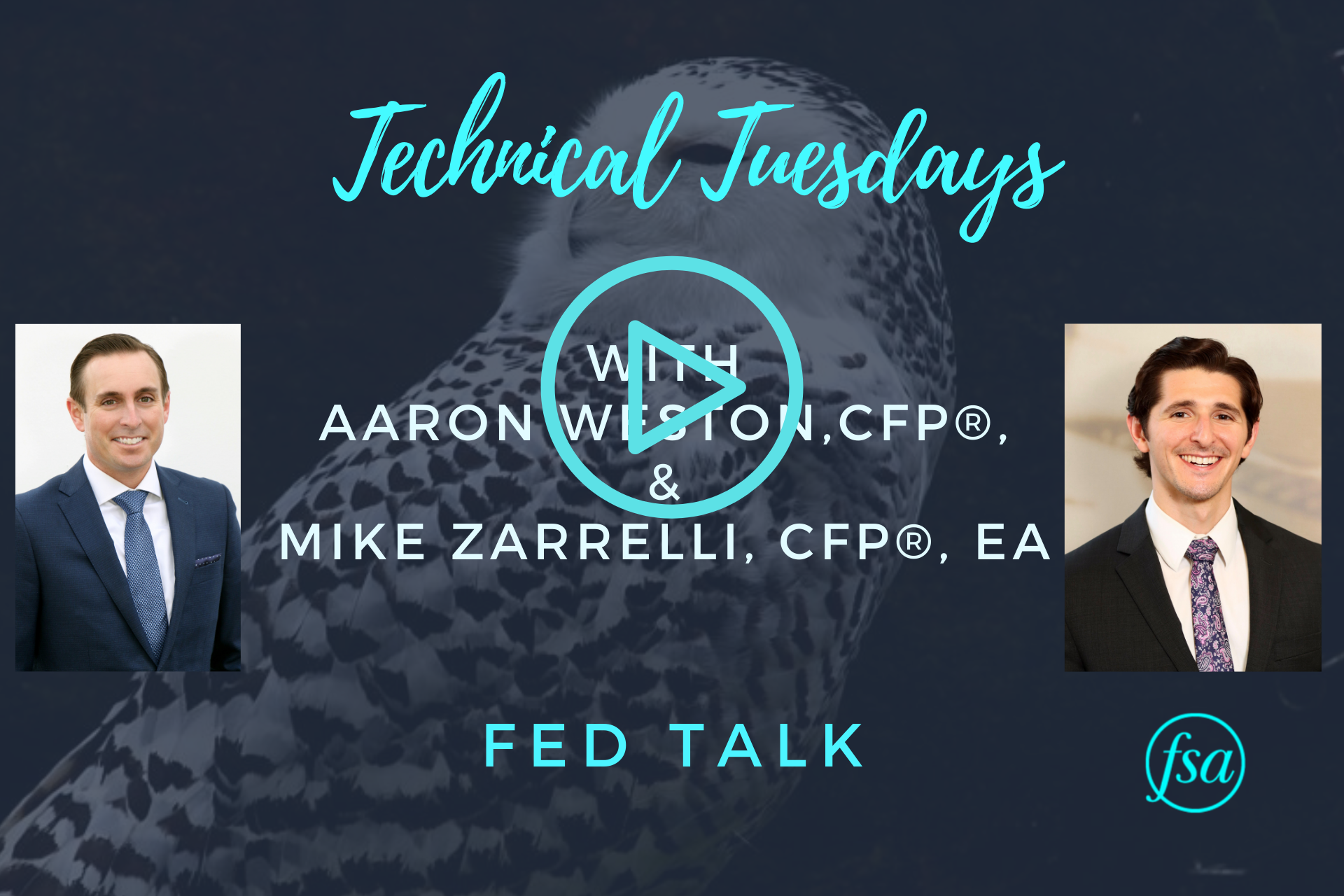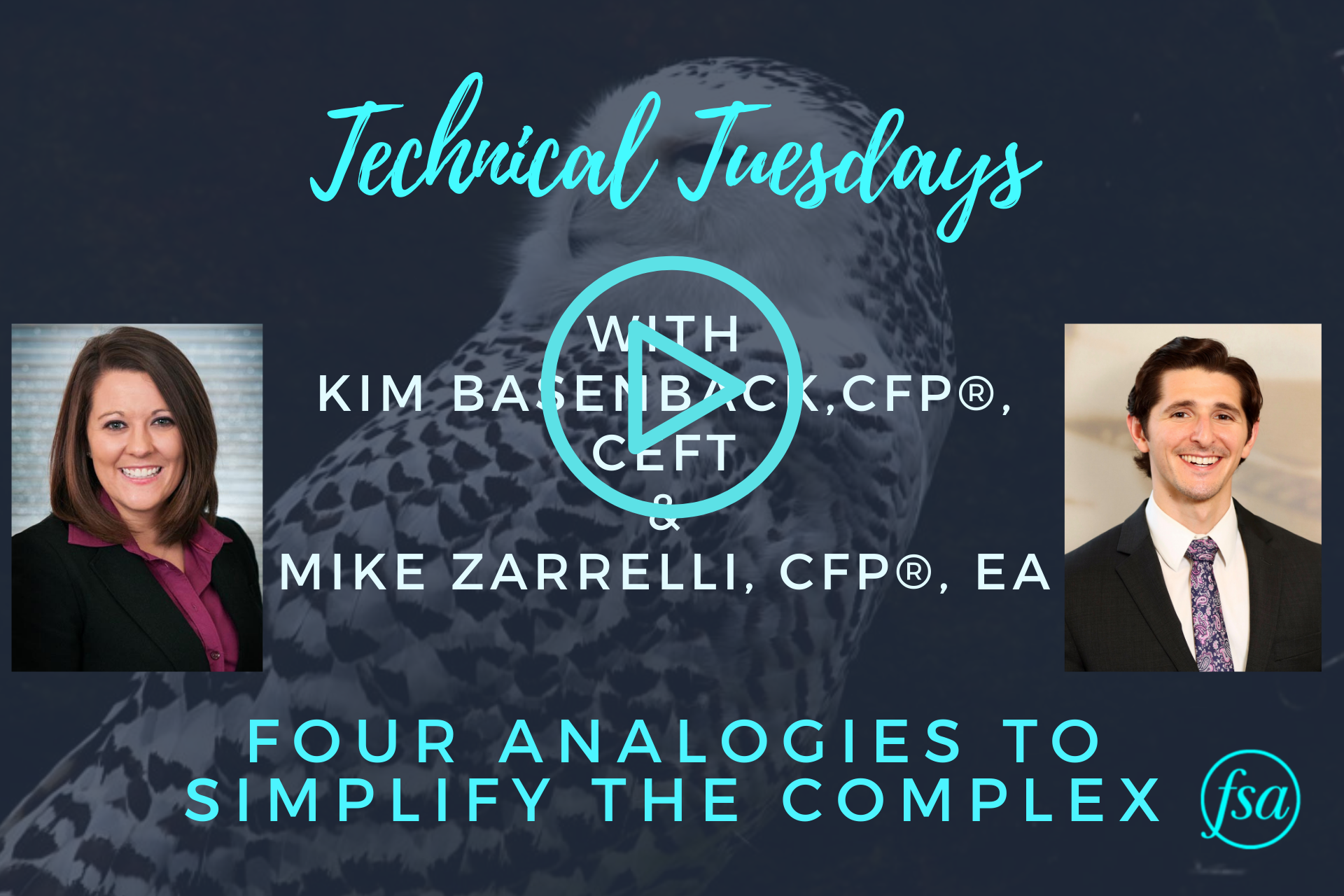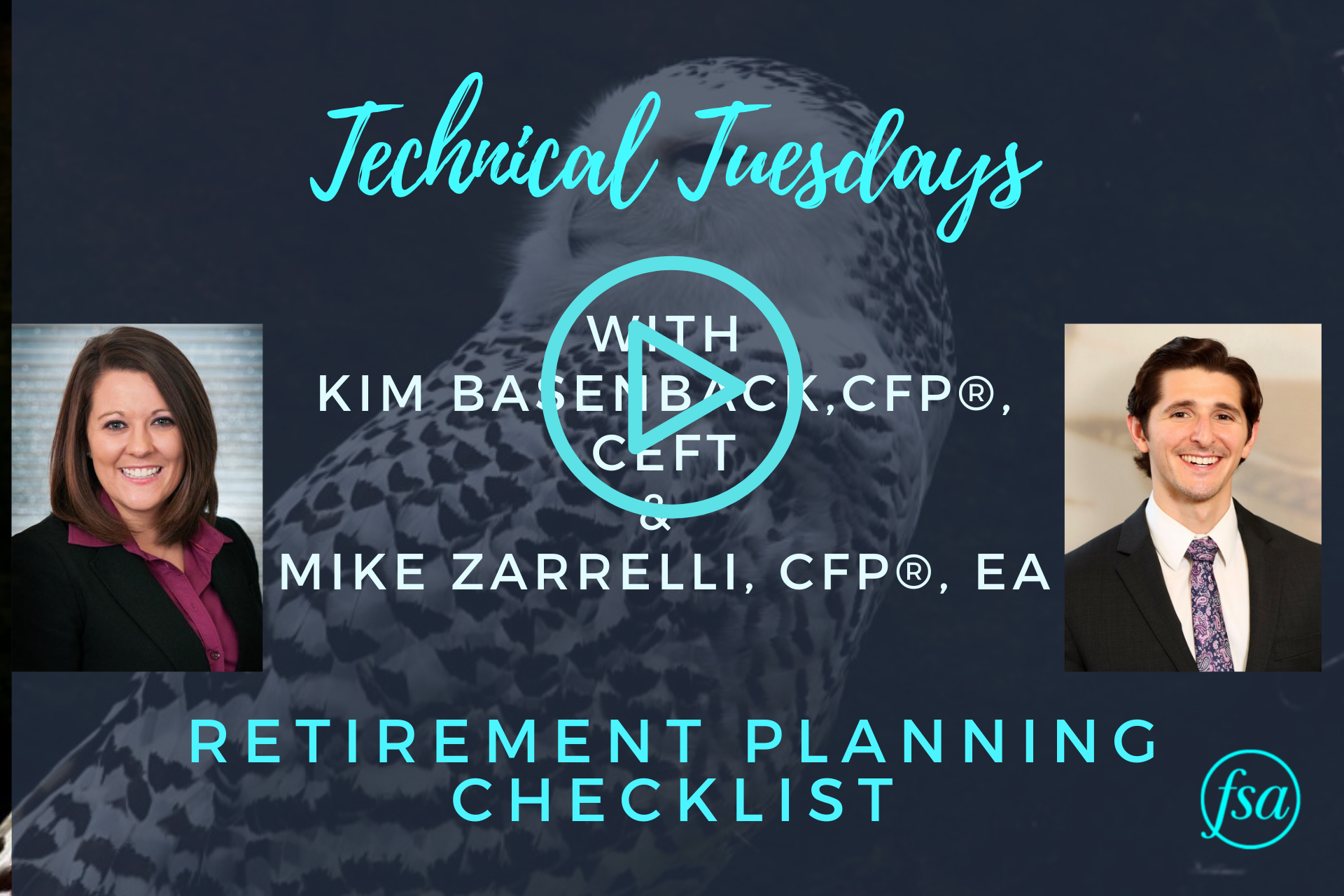In our March 2021 Technical Tuesdays video, Mike Zarrelli and Derek Kravitz talk about 401(k)s and their importance.
Benefits of a 401(k) Transcript
Derek Kravitz:
Hi, everybody. This is Derek with FSA again with another Technical Tuesday video. We’ve got Mike Zarrelli here again. He’s going to be talking to us about 401(k)s and why they’re so important. So without further ado, Mike, what’s a 401(k), and why is it so important?
Mike Zarrelli:
Well, Derek, 401(k)s are extraordinary savings vehicles sponsored by your employer. In fact, most millionaires first reach millionaire status through their 401(k)s. Fidelity did a research study in 2020 and found that there were 233,000 401(k) millionaires. It’s pretty powerful.
Now one reason 401(k)s are one of the best places to build wealth is that with your contributions to the 401(k) there’s an added tax benefit. So, with your contributions, you can stick it to the tax man by either doing a pre-tax contribution or a Roth contribution. A pre-tax contribution is taken out of your paycheck, but it’s before taxes are taken out. So you skip out on the taxes now, the money in the 401(k) grows tax-deferred, and taxes are only owed on the amounts you’re taking out of the 401(k) when you’re in retirement. Conversely, Roth contributions, they are taken out of your paycheck, but it is after taxes. So you pay the taxes now, but then the money gets to grow tax-free. And then when you take the money out in retirement, no taxes are owed at all. Pretty powerful.
Derek Kravitz:
So yeah, that’s hugely powerful. And it’s actually something that I didn’t know about prior to working at FSA. I was previously under the impression that your max Roth contribution in any given year was 6,000; it would go into a Roth IRA. I had no idea that there was a Roth 401(k) option and that sort of opened up a whole new world for me.
Can you talk to us maybe about the limits? How much can you contribute to a 401(k) each year, especially on the Roth side?
Mike Zarrelli:
Yeah. Great question. So, you can’t just put all the money you want into the 401(k)s. There are a limit. So, to start, the 401(k) contribution limit for the employee is 19,500. To spice it up, if you’re 50 or older, there’s an additional 6,500 that you can contribute for a total of $26,000 per year. So that’s on the employee side. Now the employer, they can add a sweetener as an employer match. So, they can do a dollar for dollar or a percentage of your contributions. So, your employer might say, “Hey, if you put in 4%, I’ll put in 4%,” and that way your total with your contribution and the match, you’re putting in 8% each paycheck. On the flip side, they could do, “Hey, you put in 4%, I’ll put in 50% up to your 4%,” meaning you put in 4% and I’ll put in 2%. Now there’s limits on that side as well. So combined between the employer and the employee, there is a maximum of $58,000 you can put in a 401(k) each year. If you include the catch-up provision, it’s 64,500.
Derek Kravitz:
Yeah, that’s a good chunk of change. If you are able to store it away, that would be really, really healthy for your retirement savings.
Now, just given what you had said on the onset about Fidelity had this study about 401(k) millionaires, we thought it would be a little bit fun to just play with the numbers and figure out how long it would take to get to a millionaire status in your 401(k). So assuming an annualized growth rate of 4.5%, you would need to sock away $16,392 over a 30-year period. Now that’s actually at the conservative end of your working life. That’s assuming you start at 30 years old and end at 60 years old. So if you can even start earlier than that or if you plan on working until 65, you’ve got some more runway there. But that’s attainable because a) theoretically, you make more money as your career progresses. Sixteen thousand should be a more attainable number on average if you average it out over those 30 years. But also because of that employer match which I think is something that is an incredibly, incredibly powerful tool in this journey of saving for retirement because, despite whatever market volatility may occur, that’s guaranteed money. You know, your employer is saying I’m going to give you 2% or 4% or whatever it is and that’s locked in. That’s good. I mean, that’s hugely powerful.
Mike Zarrelli:
Yeah, you definitely want to get that employer match. But there’s a couple of other things you can do to help with growing to this million dollars. There’s the fee side. Do you want to hit the fees that might happen in a 401(k)?
Derek Kravitz:
Definitely. So, this is something else that we ran the numbers on, and oftentimes in some way, shape, or form, there will be a fee associated with your 401(k) plan. Whether this is paid by your employer or by the employee, it’s worth checking into, and we’re going to discuss why here
So, assuming you have a 401(k) plan that you pay 1% on the balance at the end of each year on, assuming that same 4.5% annualized growth rate, you would end up paying $53,590 over the 30-year timeframe of that 401(k) with a 1% fee. Now that figure is taking into account both the fee that’s assessed at year end and also the opportunity it cost of having not invested that fee. So that’s a hugely, hugely powerful compounding effect there on something that is no longer yours if you’re paying this fee.
Now, that of course, goes up with higher fees, and higher fees in 401(k) plans, they’re not unheard of. So at 1.5%, it’s $76,593.93, and at 2%, it’s a whopping $97,404.43. Now I should add the caveat too that this isn’t assuming the same contribution level that we did prior with the millionaire study. This is assuming just a simple $5,000 annual contribution. But still, the effects are very powerful. So my advice would be check into what fees you’re paying in your 401(k) plan and maybe have a discussion with your employer, if they’re on the high end, about how those fees can be brought down because it’s definitely something that you want to pay attention to because over time it can make a big difference.
Mike Zarrelli:
Yeah. Great point.
Derek Kravitz:
So, another thing that I was going to cover as well from my end is that you also want to take a look at what your investment options are in your 401(k) because you might have a 401(k) plan where there’s a bunch of different fund options but you might only have three or four funds to pick from to invest in. And it could be a broad-based market index, broad-based bond index, but you also want to check in and see what fees are being charged in those funds because that’s another added layer of fees and opportunity cost that you may be paying without knowing it. And if you only have a few funds, again, maybe something you want to address with your employer, HR, whoever that you can speak to about this topic at your job and find out if there’s the ability to have more fund options, more investment choices because the more choices the better. If you have fund A and fund B and they essentially do the same thing but one’s charging twice the amount of fees, that’s something you want to look at because presumably over the long-term you’re going to be invested in one of these vehicles. You, of course, want to be paying the lower of the two fees for the same outcome. So that’s something that you would want to take a look at as well.
Mike Zarrelli:
Yeah. Yeah. Great point. Reaching out to your HR can’t hurt when it comes to investment options and the fees within the 401(k).
Derek Kravitz:
Exactly. Yeah. Always want to investigate what you’re paying and what you’re getting in return. And I’m not saying don’t pay any fees at all, but you need to be getting the right level of service for what you’re paying. So it’s just something to look at.
Mike, I wanted to ask you too about, obviously there’s several instances in people’s lives where they may change jobs or they will change jobs. You know, I think gone are the days where somebody may work at the same place for their entire working career. If you do leave your current job, what happens to your 401(k) that you started with that job at? Where does that go?
Mike Zarrelli:
Yeah. Good question. So there are a few options you have when you leave the current company, whether it’s retirement or you just found a new job. So there’s a few options. First one is you can just leave the 401(k) exactly where it is. Now you’ll be stuck with those investment options and those fees, but you can just leave it alone. Your second option is you can take a total distribution check for the full amount. Now this is almost never recommended because it is a taxable event. So if you have a hundred thousand dollars in your 401(k) and you take a full distribution, you could have a pretty hefty tax bill. Lastly, you can roll the old 401(k) into your new employer’s 401(k), assuming they allow that, or you can open a IRA at a custodian like Charles Schwab and roll the 401(k) into there, and that will provide you with more investment options and more than likely less fees.
Derek Kravitz:
That makes sense. Yeah. That’s definitely something to keep in mind if you switch jobs.
Well, Mike, I think we’ve covered it. Is there anything else that we missed that you wanted to bring up today?
Mike Zarrelli:
Yeah, I think we hit the basics. Just if you have any questions about 401(k)s or maybe you want us to take a look at your investment options, feel free to reach out to us at questions@FSAinvest.com.
Derek Kravitz:
Perfect. We’ll leave it there. Thanks everybody for watching. And thanks, Mike, for your expertise once again.
FSA’s current written Disclosure Brochure and Privacy Notice discussing our current advisory services and fees is available at www.FSAinvest.com/disclosures or by calling 301-949-7300.




